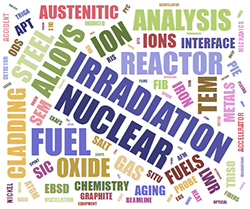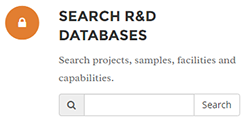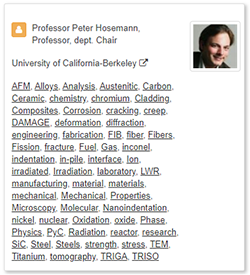NSUF Article
NSUF Websites Updated
We are pleased to announce the launch of a new version of the Nuclear Science User Facilities websites. This update contains new features to improve collaboration and the proposal reviewer selection process, a complete overhaul and upgrade to the various search systems used to locate research and development data, and a new feature to allow result pages to be fully compatible with smaller resolution devices.
Dynamic Keywords

Keywords displayed in 'word clouds' located on the Nuclear Energy Researcher Database (NERD), Nuclear Energy Infrastructure Database (NEID) Institution Researchers tab, and the Profile edit screens have also been extended to include generated keywords for researchers and make it easier to search by keyword, or select keywords for your profile when editing.
Search Upgrades

The irradiated samples in the Nuclear Fuels and Materials Library (NFML) can now be searched by irradiation conditions and/or keyword, using a newly designed form interface that will allow you to fine-tune values for Dose (DPA), Temperature (°C), and Fluence (n/cm²). If the form is submitted with no changes, the maximum amount of samples in the library will be returned, so the backend systems have been highly optimized to allow result pages to load nearly 7,000 samples within moments. Search results have been expanded to include the irradiation conditions for each sample and the current availability of the sample for research.
The search forms for locating Institutions, Facilities, and Capabilities in the Nuclear Energy Infrastructure Database (NEID) have been improved so that selections made are persistent when the search is modified from the results page. Optimizations on the search processing have also greatly improved the speed and responsiveness of this search.
Card View

This new viewing mode can be triggered by clicking a 'Change Views' button located to the side of the selection control that changes the amount of records to be displayed on the screen. The viewing mode is persistent for that page, and will be remembered on your next visit. The controls to search, sort, and filter data still work with the card view, and any links, buttons, or other interactive elements in a grid will work the same way when viewed as cards.
Card view is available now for all data pages in the NSUF website: Partner Facilities, Partner Institutions, Awarded Projects, Research Publications, Conference Presentations, and the Nuclear Fuels and Materials Library Search. Additional grids will be upgraded to support card view in future updates.
Articles
About Us
The Nuclear Science User Facilities (NSUF) is the U.S. Department of Energy Office of Nuclear Energy's only designated nuclear energy user facility. Through peer-reviewed proposal processes, the NSUF provides researchers access to neutron, ion, and gamma irradiations, post-irradiation examination and beamline capabilities at Idaho National Laboratory and a diverse mix of university, national laboratory and industry partner institutions.
Privacy and Accessibility · Vulnerability Disclosure Program

